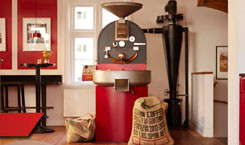The coffee roasting processes
Learn more about the different roasting methods for coffee and espresso. Their influence on the aroma and preparation.
The roasting processes
Unimaginably large quantities of coffee are consumed worldwide. Not only the cultivation, but also the roasting methods have changed significantly over time and have developed into a real craft today. Initially roasted in clay pots, there are now two main processes, the drum roasting process and the hot air roasting process.
The traditional drum roasting process
The so-called drum roasting process is mainly used in smaller, traditional roasting companies. Drum roasters are available in a wide variety of sizes, nowadays even for home use. In this process, the green coffee is placed in a rotating drum that is heated from the outside. Through direct contact with the surface, the heat is evenly transferred to the beans. This very gentle method allows aromas to develop particularly well, and the long roasting time of 15-20 minutes at 180-230°C breaks down or minimizes many acids. Through a small opening, the roast master constantly takes samples to determine the degree of roasting based on the coloring and to interrupt the process at the right moment. Above all, the roast master needs a good eye and a lot of experience to produce perfectly roasted coffee with a consistent taste. To prevent the heat contained in the beans from driving the roasting process longer than desired, the coffee must then be cooled. In drum roasting, the coffee is poured directly from the drum onto a sieve. Through the openings in the sieve, cold air flows around the beans, which are moved evenly by an agitator, and cools them down to about 30°C.
Hot air roasting process
Since coffee is more popular today than ever before, industrial solutions for coffee roasting also had to be found. In large roasting operations, roasting with hot air can save time and costs in particular. The machines, usually designed as continuous roasters, consist of a large, perforated drum with a screw conveyor on the inside. At up to 700°C, the beans are roasted for only one to five minutes and then cooled with water. Although this process enables fast and inexpensive roasting, the quality sometimes suffers greatly. Since the bean types are not roasted separately, it happens that large beans are not yet roasted through and small beans are already roasted too strongly and darkly. Due to the extremely short roasting time, the incompatible chlorogenic acids also have much less time to decompose. In addition, the cooling water distorts both the weight and the aromas of the coffee.
So really good roasts come out of the drum. Here at Espresso International, we also place a lot of emphasis on the quality of our products, so all of our coffees are gently drum roasted.

